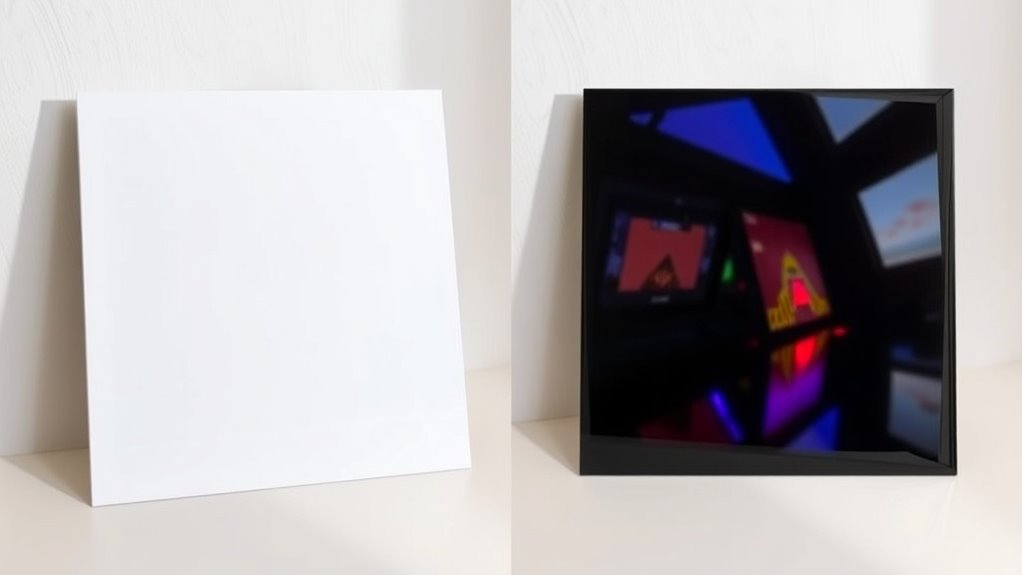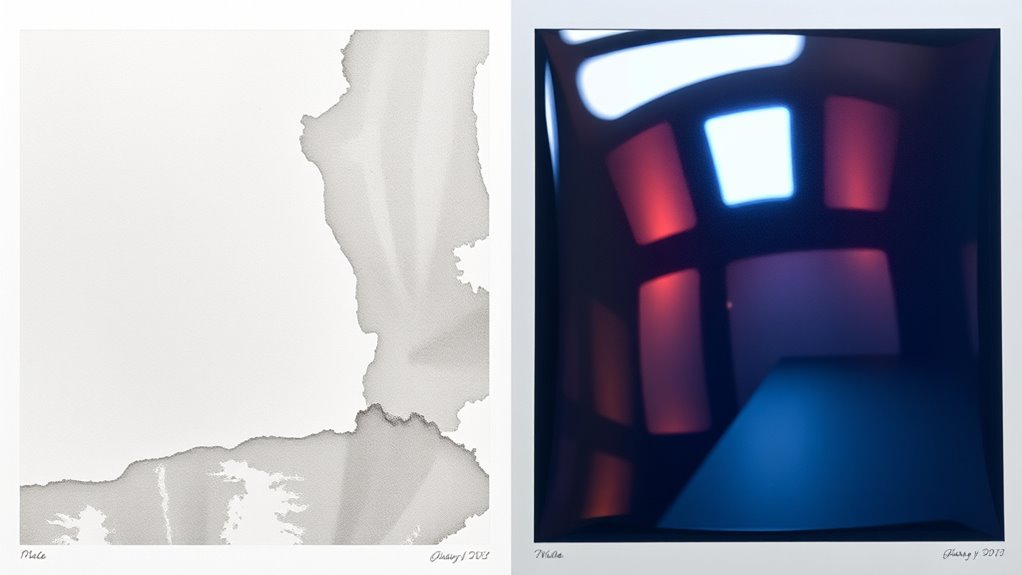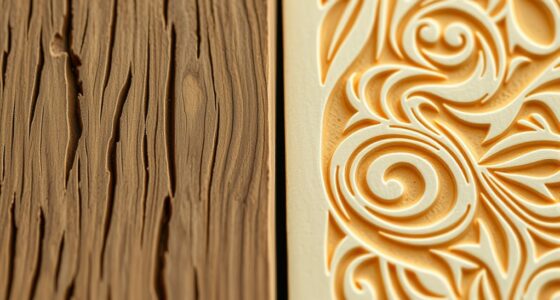If you choose a matte finish for your fine-art print, you’ll get a subtle, non-reflective surface that minimizes glare and hides fingerprints, ideal for close viewing and detailed work. Glossy finishes make colors pop and add vibrancy, creating a sleek, reflective look that enhances depth and richness but shows surface imperfections more easily. Depending on your environment and artistic intent, one finish may suit you better—stay with us to learn more about their unique benefits.
Key Takeaways
- Matte finishes offer a subdued, non-reflective surface ideal for detailed viewing and minimizing glare.
- Glossy finishes enhance color vibrancy and depth, making artwork appear more lively and eye-catching.
- Matte surfaces hide fingerprints, smudges, and surface scratches better, reducing maintenance needs.
- Glossy finishes are more resistant to minor scratches and easier to clean, but show surface imperfections more readily.
- Choice depends on artistic intent and environment, balancing visual impact with durability and ease of maintenance.

When choosing a finish for your project, understanding the differences between matte and glossy options is essential. These finishes influence not only the appearance but also how your fine-art prints will interact with light and viewers. The texture comparison between matte and glossy finishes plays a significant role in setting the mood and feel of your artwork. A matte finish offers a smooth, non-reflective surface that diffuses light, giving your print a soft, muted look. It creates a subtle, understated texture that minimizes glare and fingerprints, making it ideal for detailed works or pieces meant to be viewed up close. Conversely, a glossy finish provides a shiny, reflective surface that enhances colors and details, giving your print a vibrant, lively appearance. The glossy texture is smooth and sleek, often making colors pop with depth and richness. This high-shine surface can add a sense of depth and dimension, making details more striking but sometimes emphasizing surface imperfections or fingerprints.
Durability differences are also vital to evaluate. Glossy finishes tend to be more resistant to minor scratches and smudges because their smooth surface repels dust and dirt better than matte finishes. However, their high reflectivity can make fingerprints more noticeable, requiring frequent cleaning. Matte finishes, on the other hand, are less prone to showing fingerprints and smudges, which can help maintain a clean look over time. They are also better at hiding surface scratches, making them a practical choice for artworks that will be handled or displayed in busy environments. However, matte surfaces may be more susceptible to surface abrasions that can dull the texture or cause slight discoloration over time. Additionally, the choice of finish can influence the perceived visual depth, affecting how immersive your artwork appears to viewers.
The choice between matte and glossy finishes ultimately depends on your aesthetic goals and how you want your art to interact with its environment. If you favor a subdued, elegant look with minimal glare, matte is your best bet. If you want vibrant colors with a vivid, eye-catching finish, glossy will serve you well. Keep in mind that durability differences can influence long-term maintenance; glossy prints may require more careful handling to prevent fingerprints, while matte prints tend to hide everyday wear better. By understanding these key aspects—texture comparison and durability differences—you can select the finish that aligns with both the artistic intent and practical needs of your project, ensuring your fine-art print looks stunning and remains preserved for years to come.
Frequently Asked Questions
How Do Finishes Affect Print Longevity?
Finishes markedly impact your print’s longevity by offering protective coatings that shield against environmental factors like UV rays, moisture, and dust. A well-chosen finish helps preserve colors and details over time, preventing fading and deterioration. Glossy finishes often provide a durable surface that resists scratches, while matte finishes reduce glare and fingerprints. By selecting the right finish, you guarantee your fine-art print stays vibrant and intact for years to come.
Which Finish Is Better for Outdoor Artwork?
Imagine your outdoor artwork battling relentless sun and weather—what finish can save it? You need a matte finish for UV protection that shields your print from fading, or a glossy finish for vibrant enhancement that makes colors pop despite the elements. While gloss boosts vibrancy, matte reduces glare and offers better durability outdoors. Choose wisely: if long-lasting color and weather resistance matter most, a matte finish is your hero.
Do Finishes Impact Color Accuracy?
Finishes do impact color accuracy, especially through their surface texture. A glossy finish enhances color saturation, making hues pop and details sharper, but it can also cause glare. Matte finishes reduce glare and offer a softer look, which may slightly dull color saturation. Your choice depends on whether you want vibrant, eye-catching images or a more subdued, glare-free appearance. Consider how surface texture influences your viewing experience and display environment.
Can Finishes Be Changed After Printing?
Did you know that changing a print’s surface can alter its appearance considerably? While you can’t typically change the finish after printing, you can choose the right print surface options and finish application techniques beforehand. To achieve your desired look, discuss your finish preferences with your printer, as some finishes can be added or modified during the final stages. Planning ahead ensures your art looks exactly how you envision.
Are There Specific Finishes for Black-And-White Prints?
When choosing finishes for black-and-white prints, consider options that enhance monochrome contrast and grayscale depth. Satin or matte finishes work well because they reduce glare and highlight subtle tonal variations, giving your print a timeless feel. Glossy finishes can make blacks pop but might reflect light, which can diminish the depth. Select a finish that complements your artistic intent and guarantees your grayscale details are vividly preserved.
Conclusion
Choosing between matte and glossy finishes is like selecting the lens through which your art’s soul shines. Matte offers a quiet, understated depth—like a moonlit night—while glossy dazzles with vibrant life, reminiscent of a sparkling sunrise. Your final choice is the brushstroke that completes your masterpiece’s story. Trust your instinct, and let the finish symbolize the emotion you want your viewers to feel. After all, your print is more than ink—it’s a reflection of your vision.









